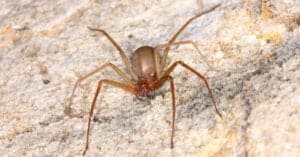Colorado is home to around 200 different species of arachnids, including several spiders that have a black body. Several types of venomous spiders reside in Colorado. The most well-known is the black widow, with three different species of this spider found in the state.
Colorado’s forests, deserts, and variety of different trees and shrublands make an ideal home for a variety of unique spiders. From huge tarantulas to tiny cobweb spiders, several common black spiders reside within the state. This article lists six black creepy crawlers you might spot in Colorado.

1. Black Widows
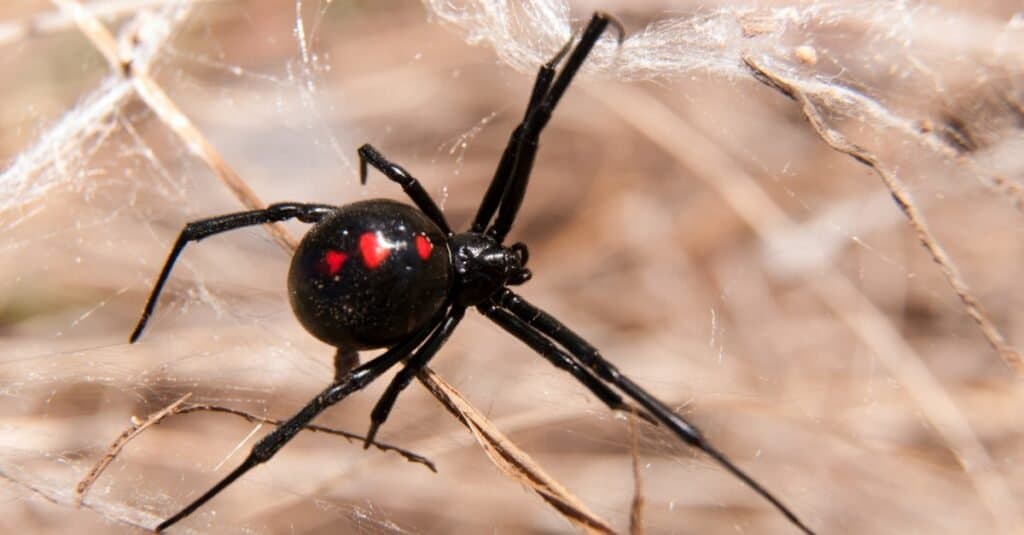
Only female black windows inject venom, which is known for having neurotoxic properties that harm the nervous system.
©Sari ONeal/Shutterstock.com
Three types of black widow spiders can be found in Colorado: the western black widow (Latrodectus Hesperus), the southern black widow (Latrodectus mactans), and the northern black widow (Latrodectus variolus).
Black widows create webs both indoors and outdoors, where they might come into contact with humans. They prefer to settle down in quiet and dark areas, such as gardens, wood piles, garages, and construction sites.
Only female black widows inject venom, which is known for having neurotoxic properties that harm the nervous system. The bite results in pain and swelling, and you should seek medical attention if you have been bitten.
Identifying a black widow can be tricky; don’t confuse it with the false black widow (Steatoda grossa), which looks quite similar. The female black widow’s coloration is a deep shiny black, with red markings on their abdomens. They can reach a size of 0.25 to 1.5 inches, with females being larger than males.
2. Mouse Spider
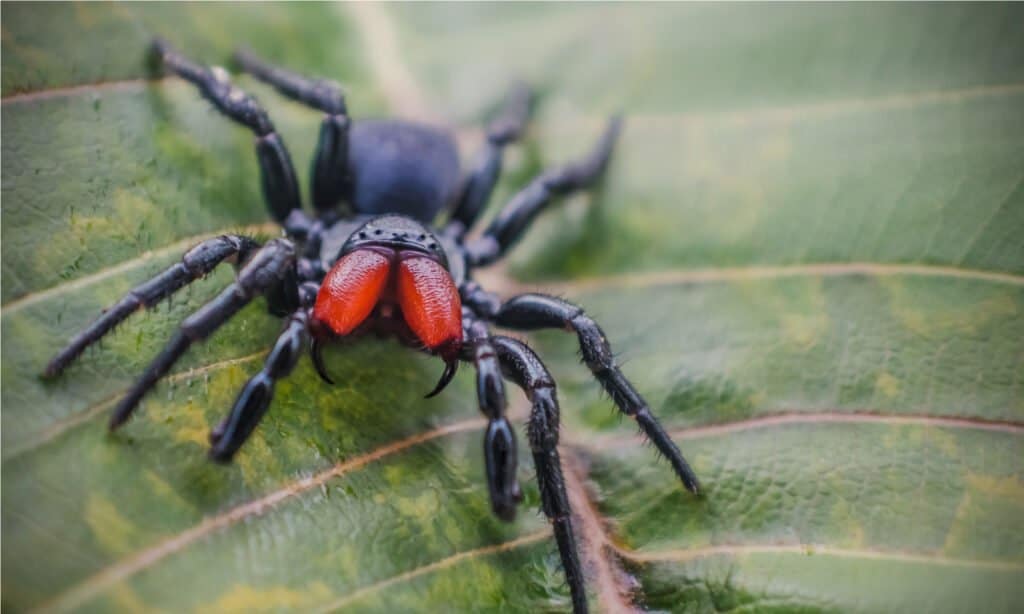
The most noticeable feature of a mouse spider is its large and prominent bright red fangs.
©Brittany North/Shutterstock.com
Mouse or Missulena spiders are from the mygalomorph genus and can be found throughout Colorado. These are interesting-looking spiders that have sexual dimorphism and feature either a black or dark brown coloration. The males have longer legs than the females, who have larger and stockier bodies.
These spiders grow to a size of 0.40 to 1.2 inches, and the female is bigger than the male. The most noticeable feature of a mouse spider is its large and prominent bright red fangs.
These fangs can inject venom that is dangerous to humans, and their bite can make you feel very ill.
Mouse spiders create deep burrows in the sand, where they spend most of their time. These spiders have thick legs that make them strong diggers. Their mouth can have a reddish tint, and certain male mouse spiders have a blue hue on their heads.
3. Carolina Wolf Spider

Unlike other wolf spiders, like the one pictured here, the Carolina wolf spider only grows to an adult size of 0.43 to 1.38 inches.
The Carolina wolf spider (Hogna carolinensis) is one of the 2,000 types of wolf spiders. Unlike other wolf spiders, the Carolina wolf spider only grows to an adult size of 0.43 to 1.38 inches. These spiders have black undersides with a dark brown body, along with fine hairs on their legs.
The female is larger than the male, a pattern that spans across many spider species. Carolina wolf spiders prefer to inhabit woodlands, coastal forests, and suburban gardens.
These spiders are venomous. If they do happen to bite a human, you may experience itching, burning, and general swelling around the injection area. This is because the Carolina wolf spider’s venom contains lycotoxins, making it a paralytic agent.
4. Black Cobweb Spider

Common names for this arachnid include the black cobweb spider, brown house spider, and cupboard spider. It is also known as the Female False Katipo spider Steatoda capensis
The black cobweb spider (Steatoda grandis) is a common spider found in the United States, with a medically significant bite. The bite of a black cobweb spider is painful, and it can make you sick. In severe cases, victims can have nausea, dizziness, pain, headaches, and malaise for a few hours after being bitten. The bite can also form a blister, which burns and is uncomfortable for a few days.
These spiders have a predominantly black body with a light brown marking on their abdomen. You can find the black cobweb spider in homes or outdoors in dark and secured areas. They prefer vegetation and plenty of hiding spaces. Their size ranges from 0.23 to 0.59 inches in females, with males being on the smaller end at 0.20 to 0.40 inches.
5. Grand Canyon Black Tarantula
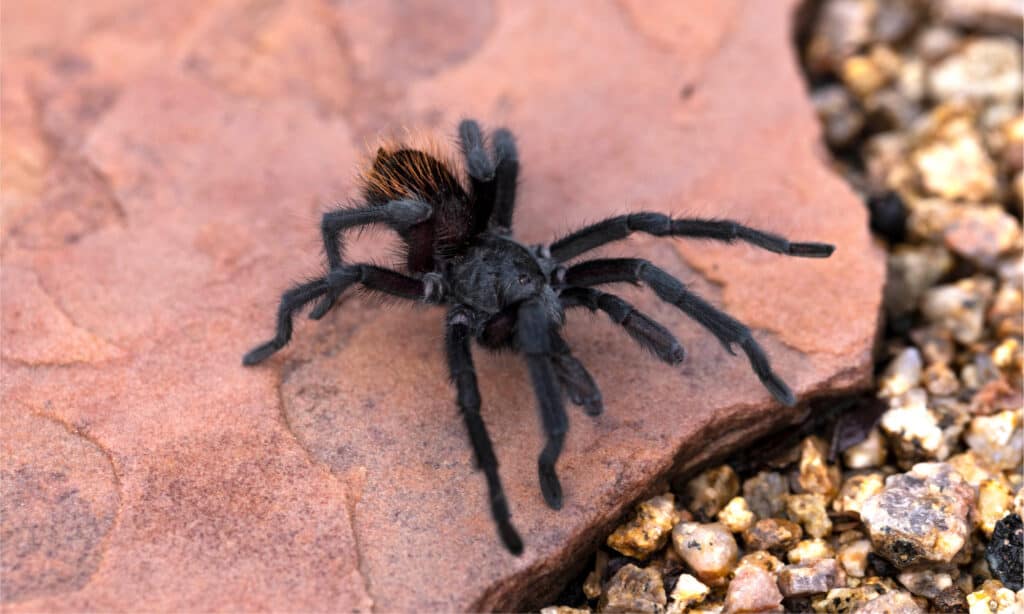
Males have smaller abdomens when they are mature, and they appear much “leggier” than females.
©Malisa Nicolau/Shutterstock.com
The Grand Canyon black tarantula (Aphonopelma marxi) is a type of desert spider. They are from the Theraphosidae family and have a predominantly black coloration with fine hairs on their bodies and reach a size of 4 inches. As its name suggests, this tarantula can also be found in the Grand Canyon area, in forests and desert regions.
Besides having a black body, the Grand Canyon black tarantula has reddish-orange hairs. The females are much larger than males, but they have shorter legs. Males have smaller abdomens when they are mature, and they appear much “leggier” than females.
Males have shorter life spans, living up to eight years of age, while females can live up to 20 years! During the breeding season, males go on a walkabout in search of a mate. For this reason, males are more often spotted than females during certain times of the year.
6. Red-Spotted Ant Mimic Spider
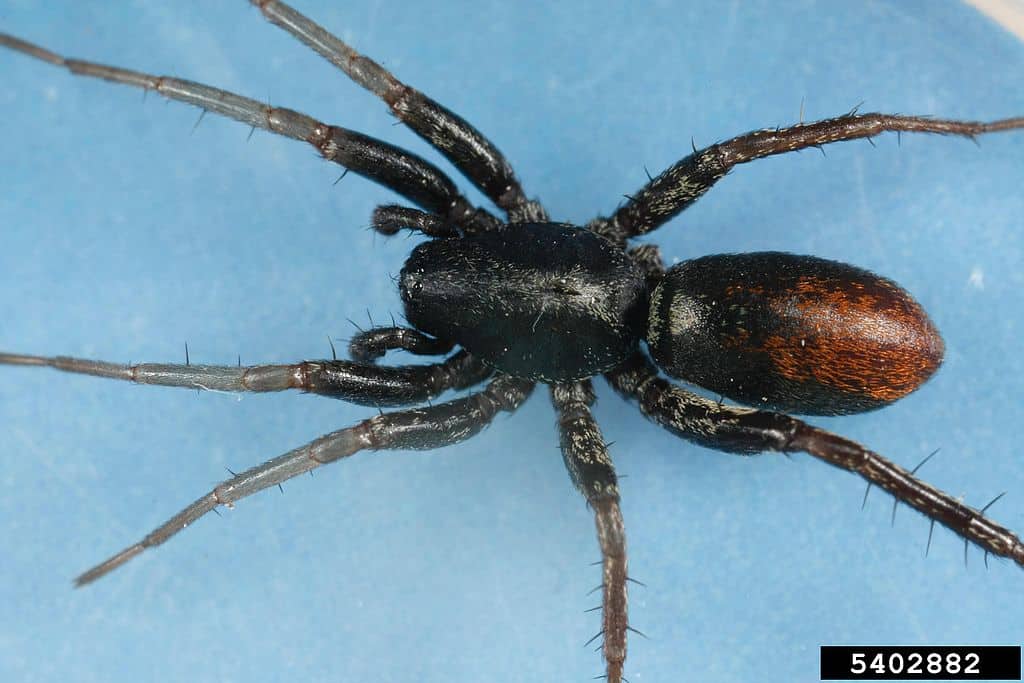
These spiders wander around with their front legs in the air, which gives them an ant-like appearance. In this way, they can catch insects off guard.
©Joseph Berger, Bugwood.org; University of Georgia / CC BY 3.0, via Wikimedia Commons – Original / License
Red-spotted ant mimic spiders (Castianeira descripta) are hunting spiders, meaning they search for prey rather than catching it in a web. These small spiders with an interesting appearance have a unique method of catching food. They wander around with their front legs in the air, which gives them an ant-like appearance. In this way, they can catch insects off guard.
Their habitat includes woodlands, shrubs, and areas with lots of stones, sticks, and vegetation. The female reaches a size of 0.5 inches, while males are smaller at only 0.38 inches.
Due to their black body and red markings on the abdomen, they are often mistaken as a black widow spider. However, ant mimic spiders are slightly smaller and have pointed legs with a light brown coloration on the end.
They have an aggressive bite that causes pain in humans, although they only bite humans in rare cases of defense. Their bite can cause swelling and a burning feeling, similar to the sting of a bee.
Summary of 6 Black Spiders in Colorado
| Rank | Black Spider | Dangerous? |
|---|---|---|
| 1 | Black Widows | Venom has neurotoxic properties that harm the nervous system |
| 2 | Mouse Spider | Fangs can inject venom that is dangerous to humans |
| 3 | Carolina Wolf Spider | These spiders are venomous |
| 4 | Black Cobweb Spider | Bite is painful and it can make you sick |
| 5 | Grand Canyon Black Tarantula | Generally harmless; only bite if provoked |
| 6 | Red-Spotted Ant Mimic Spider | Aggressive bite that causes pain in humans |
Thank you for reading! Have some feedback for us? Contact the AZ Animals editorial team.







